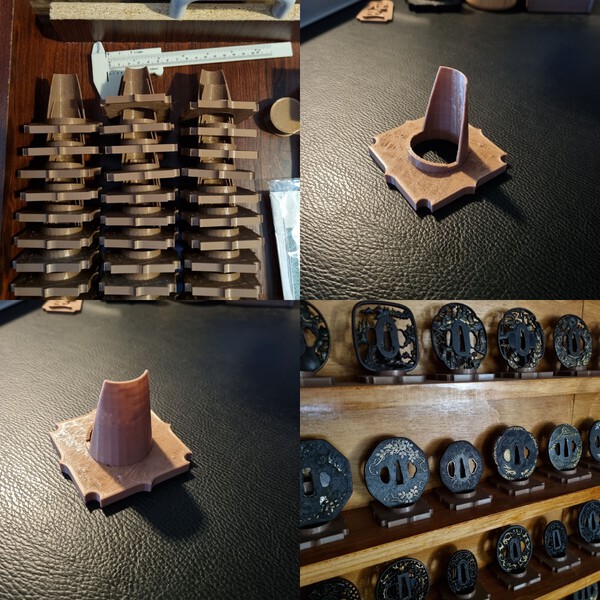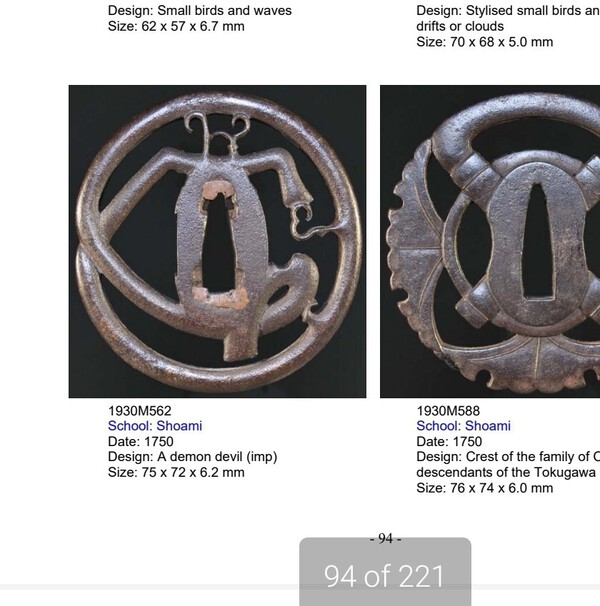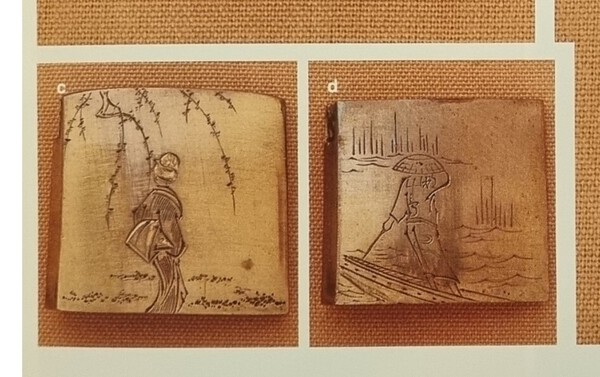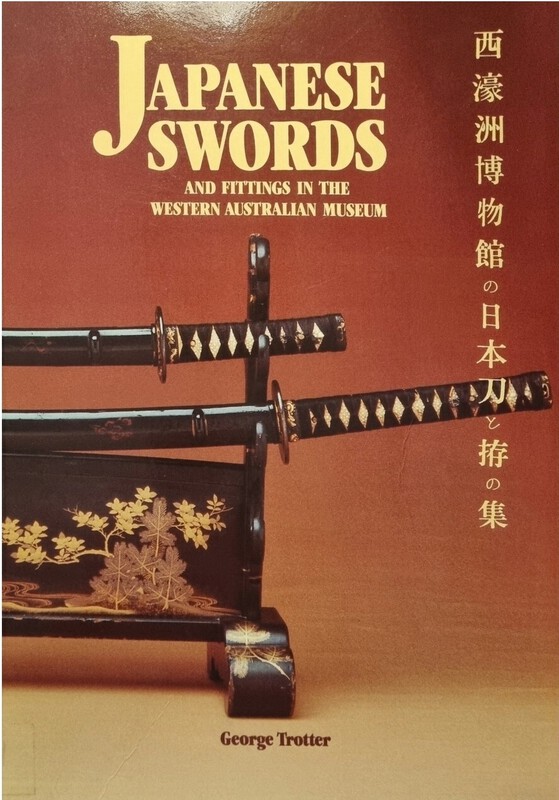-
Posts
648 -
Joined
-
Last visited
-
Days Won
3
Content Type
Profiles
Forums
Events
Store
Downloads
Gallery
Everything posted by Steves87
-
Well, I am voting for the ultra leftside theory of "a new style of shingen" 😉
-
I really like the wood patterning on that, congratulations on your acquisition. I don't really know anything about cicada, but I came across this one yesterday. https://www.ebay.com...r=artemis&media=COPY
-
Basically the same design, nice thinking Jean! You achieved a very effective design naturally, in only 4 cuts!
-
Nice one Jean, stand damage really should not be an issue if both are stagnant. I'd really only worry about moisture absorption when holding iron, or materials that 'off-gas', otherwise most 'soft' materials should be ok?
-
Hi Justyn, I can understand your concern. I can confirm that I have now just checked three soft metal Tsuba (one with Nanako - a polished face - and a Chidori-ishime finish), and none show any signs of wear. One of these has been propped by the stand for at least three years, and I have been using the stands for nearly 7 years on most (or all) Tsuba construction materials. The contact surfaces of this stand are technically only small 4 areas (less than a millimetre each); two at the bottom on the mimi, and one either side of the Nakago-ana (within the seppa-dai). The plastic you use is dependent on what filament you personally prefer... I use PLA which can be scratched with a fingernail. I use this material in its print-extruded state with all sorts of bare-untreated-unpatinated metals and it has not caused any form of corrosion to date (including Chinese-made functional dojo katana blades). I guess one thing to consider, is how much movement your object will be making while in the stand; technically, the object should not be moving at all. I say technically because: in a previous profession I worked in for over 20 years, we did study the effects of vibrations (from wind/traffic/sounds etc) on buildings and the effect these vibrations had on the building (and the contents too, in some cases). High rise buildings move a lot through sway and wind induced vibrations, and buildings next to heavily traffic motorways are vibrated massive amounts via sound and heavy vehicle contact with the road. Potentially, the stands could mark a Tsuba that is propped by a plastic stand in these high movement cases, but even then, I would guess there is more chance of the stand being deformed first, and I'd say there is more chance of a timber stand causing damage to a Tsuba, before the plastic one does!
-
Hi everyone, I have been getting quite a few messages on instagram about the Tsuba stands I created and use. I have started to offer out the .stl file for people to make their own, and I thought it may be a good idea to share here too. They are a simple 3d printed design and can be printed very quickly, depending on the quality settings. The pictures show examples of the lowest quality setting (some minor disruptions on top of the base). If you have a 3d printer, or access to one, it is a good option for a stand that is very consistent when displayed on a shelf. https://www.dropbox....rmmh4nrt4lpz70k&dl=0
-
A lot of good advice here, two articles I think are worth reading more than once, maybe a couple of times a year are: (26) How to Collect Tsuba Like an Expert - Building a Collection | LinkedIn Haynes Article (shibuiswords.com) (second last paragraph especially) Particular take-aways from these articles is: be unique in your collecting, authentic to your interests, and do not be close-minded in your study or interest of types. Reading is very important, but it will only get you so far, you need to handle authentic and replica pieces too. I would highly suggest trying your hand at creating a Tsuba from scratch, cutting, filing, chasing, inlay, all of it... doing this will give you an appreciation of how much work still went into the Tsuba freely labelled as "junk", and what is likely needed to accomplish the exquisite museum quality guards. I suspect the majority of collectors do not truly appreciate the time and skills needed to make any level of Tsuba, especially the low-end examples. Trying your hand at making Tsuba also teaches you to spot the nuances of traditionally made items, especially through photographs, nothing handmade is perfect. I personally go for inlaid items, particularly in iron, and I focus on theme depictions as a criterion for collection... my care for smith/school is low, but having said that, I do have multiples guards within singular school classifications.
-
-
Chris is correct, I do know that Matsukaze sources at least some of their stock from Jauce... they do have a mark-up, but they are otherwise very trustworthy.
-
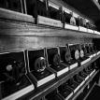
eBay Tsuba: real or scam?
Steves87 replied to thewarning's topic in Auctions and Online Sales or Sellers
this seller is one of only a few (not including private sellers) that I would recommend. After a while, if you get on with them, they make some "allowances" for you, too. Having said that, stay away from them! I don't need any more competition adding to the weak Aus dollar! -
-
I see what you are getting at, Dan. Not a bad idea, I think the main issue you will have, is the infinite different results that are possible... I have a ton of photos just like the one above and every one is different. I am almost 100% sure some of them are rust over previous unwanted/fixed rust... and getting a bit literal, iron patina is a controlled rust anyway, isn't it? Who says that between intentional hammer blows/chisel marks and various levels of intentional patina rust, a created finish cant just happen to look like a cast finish?
-
You can ignore the first two books, they should not be available at all, and new book is far superior to those. This is the link to the proof copy of the book: Tsuba, the special collection of Rolling Brooks Gallery https://www.dropbox....j873v4y9ecysnrj&dl=0 Like I have said, there are quite a few amendments in the hardcopy.
-
Thank you Peter and Dale, it is very kind... I'm generally too shy for such an intimate promotion to a forum such as this. Piers, I have a "proof" pdf copy I can share with the forum (for a limited time). I'll get on it later today. It is a proof copy and the hard copy has had quite a few things amended in it, so you will pick stuff up. Shortly after the book became live (Tsuba, the special collection in Rolling Brooks Gallery), someone contacted me and bought up a whole heap of the basic guards (As provenance and publication appears to make low end stuff much more appealing), which allowed me to acquire almost as many, more vastly superior guards. These will eventually go into an updated version (probably), but I have heap more study to do on them first. If you click my profile in Peter's link, there will be two links to the book sales, just remember I basically have no control on the sales price.
-
I'm not sure I understand the extent of small rust spotting you are trying to see, but I have quite a few that once had localised rust areas. This is one of these examples.
-
It would be interesting to get a simple poll on this Tsuba to see where the forum really sits.... Is this Tsuba cast? Yes, No.... (no maybe) I honestly cannot be sure, but I think more points to it being traditionally made, versus cast. Iron sukashi is so "easily" reproduced, that is why I tend to focus on inlaid pieces. Having said that, some of the details supporting it as cast, are also found on Tsuba with heavy inlay... if a traditionally made Tsuba with inlay can share the signs we consider as "cast" traits, then why can't an iron sukashi Tsuba also have them without being considered a casting?
-
I think they they work well as a married daisho. As Alex pointed out though, the difference in metal thickness around the hitsu-ana is the most obvious difference between the two, followed closely by the slightly different shape of the two hitsu-ana. These two differences are probably what makes them not a "true" daisho in my opinion. I think the surface condition between the two is acceptable as there is no guarantee that a daisho would be stored in a daisho kiribako, which leads to the possibility of different rates of storage/environmental conditions (that can subsequently lead to degradation). The tagane ato, if added when fitting (and not as decoration) does not need to be similar, as this can be needed at differing times from multiple fitment activities. Having said that though, if both are fitted at the same time by the same person, I would expect that (like me) they choose the same punch/method/locations? I think the size relationship is also acceptable, being large is typical, and if your have a large Katana guard, you don't want a comparitively miniature Wakizashi daisho guard.
-
hi Leon, It can be a difficult task finding a source. There is a document from Ford Hallam to make your own. Have a look, it may be something you enjoy having-a-go with.
-
I'd say Shakudo, which should be a consistent "black"
-
It's a question and a search that you will ask forever, it just doesn't have a simple answer. Have a look through this thread as this is one of the more recent
-
Is there a publicly accessible database of every papered item, including details and images? Or at least one containing the appraised items since digital word processing and digital photography has been used? That as a source, has the potential to change everything in the education of Nihonto... and drastically, especially for fittings. I haven't found it yet, so it either doesn't exist, isnt publically available (to members?), or it is advertised woefully. I feel that this type of database may be counter productive to the financial business of the NBTHK, but if education or the future of appraisals is so important, then...?
-
Thanks for this one Peter, I hadn't read this one yet, but I have the perfect chance to cite it at the moment, in a study. Page 155 brings up a point that is often asked, which side is the omote when both are identical? I usually say the omote is the side with tagane ato, if there are none, then I say the side in best condition (or most remaining zogan). I have a utsushi to the example they have given (fig4), in this case I had to go with condition (one side had slightly better nunome zogan). It would be interesting to see what others have to say. Back on topic though, I will definitely confirm the importance of using a lighted base support. It is basically the only way to take the shadows out of the sukashi, without affecting the colour and contrasts of the Tsuba plate. I still can't get it right, there is always a compromise, especially when shadows are needed to convey the relief of carvings.
-
I found these two in George Trotter's book "Japanese swords and fittings in the Western Australian Museum" while looking through it during the week. Its a pretty interesting Habaki, George did a good job on the book too. The museum may have to lift their fittings (Tsuba) game though.
-
Dale, your skills in this area are second to none! It would be great if the bonhams or christies could hire you to do their past Tsuba items!?





